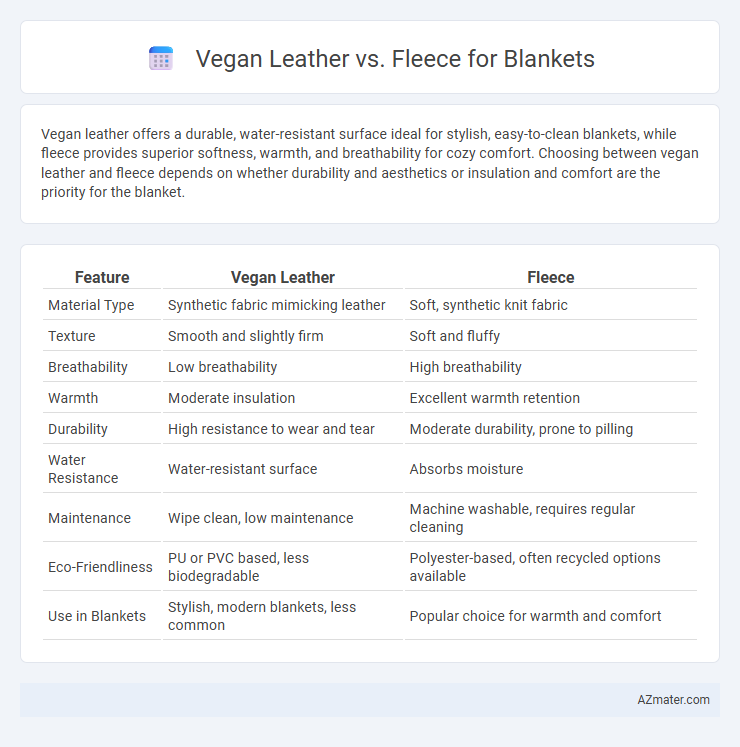Vegan leather offers a durable, water-resistant surface ideal for stylish, easy-to-clean blankets, while fleece provides superior softness, warmth, and breathability for cozy comfort. Choosing between vegan leather and fleece depends on whether durability and aesthetics or insulation and comfort are the priority for the blanket.
Table of Comparison
| Feature | Vegan Leather | Fleece |
|---|---|---|
| Material Type | Synthetic fabric mimicking leather | Soft, synthetic knit fabric |
| Texture | Smooth and slightly firm | Soft and fluffy |
| Breathability | Low breathability | High breathability |
| Warmth | Moderate insulation | Excellent warmth retention |
| Durability | High resistance to wear and tear | Moderate durability, prone to pilling |
| Water Resistance | Water-resistant surface | Absorbs moisture |
| Maintenance | Wipe clean, low maintenance | Machine washable, requires regular cleaning |
| Eco-Friendliness | PU or PVC based, less biodegradable | Polyester-based, often recycled options available |
| Use in Blankets | Stylish, modern blankets, less common | Popular choice for warmth and comfort |
Introduction to Vegan Leather and Fleece
Vegan leather is a sustainable, animal-free material often made from polyurethane or plant-based alternatives, offering durability and a sleek appearance ideal for eco-conscious consumers. Fleece, typically crafted from polyester or recycled fibers, provides exceptional warmth, softness, and moisture-wicking properties perfect for cozy blankets. Comparing these materials for blankets highlights vegan leather's stylish, water-resistant surface versus fleece's breathable, insulating comfort.
Material Composition and Production
Vegan leather blankets are made from synthetic materials such as polyurethane or plant-based alternatives like pineapple leaf fibers and apple peels, emphasizing durability and water resistance through complex chemical and mechanical production processes. Fleece blankets consist primarily of polyester fibers derived from recycled plastic bottles or petroleum, produced by weaving and knitting to create a soft, insulating fabric. The production of vegan leather generally involves more energy-intensive processes and chemical treatments compared to fleece, which is designed for lightweight warmth and breathability using streamlined textile manufacturing techniques.
Environmental Impact Comparison
Vegan leather blankets typically use synthetic materials derived from plastics, contributing to microplastic pollution and higher carbon emissions during production. Fleece blankets, often made from polyester, share similar environmental concerns but can sometimes be produced using recycled plastics, slightly reducing their ecological footprint. Both materials present sustainability challenges, with vegan leather's reliance on fossil fuels and fleece's synthetic origin demanding consideration of lifecycle impacts and end-of-life recyclability.
Comfort and Softness for Blanket Use
Vegan leather offers a smooth, sleek texture but lacks the inherent softness and warmth essential for blankets, making it less comfortable for extended use. Fleece blankets provide superior comfort due to their plush, lightweight fibers that offer excellent softness and warmth retention, ideal for cozy environments. The breathable, moisture-wicking properties of fleece ensure lasting comfort, outperforming vegan leather in terms of tactile softness and user-friendly warmth.
Durability and Longevity
Vegan leather blankets offer high durability due to their resistance to wear, scratches, and moisture, making them ideal for long-term use. Fleece blankets provide excellent softness and warmth but may show signs of pilling and fiber wear after repeated washing, impacting their longevity. Choosing between vegan leather and fleece depends on whether durability or comfort and warmth are the primary needs for the blanket.
Warmth and Insulation Properties
Vegan leather blankets offer limited warmth and insulation due to their smooth, non-breathable surface, making them less effective in retaining body heat compared to fleece. Fleece blankets are engineered with synthetic fibers that trap air effectively, providing superior insulation and warmth, especially in cold environments. The high loft and moisture-wicking properties of fleece enhance thermal regulation, making it the preferred choice for cozy, insulating blankets.
Maintenance and Cleaning Needs
Vegan leather blankets require gentle wiping with a damp cloth and occasional use of mild soap to maintain their smooth surface, avoiding harsh chemicals to prevent damage. Fleece blankets offer easy machine washing and quick drying, making them convenient for frequent cleaning, but they may accumulate pilling over time that requires special fabric shavers. Both materials demand specific care routines to retain texture and durability, with vegan leather needing more delicate handling and fleece offering greater ease in regular maintenance.
Cost Effectiveness and Accessibility
Vegan leather blankets tend to be more expensive due to the cost of synthetic materials and manufacturing processes, making them less accessible for budget-conscious consumers. Fleece blankets offer a cost-effective alternative with widespread availability, often produced from inexpensive polyester fibers. The affordability and accessibility of fleece make it a popular choice for everyday use, while vegan leather blankets are favored for their unique aesthetic and durability despite higher costs.
Ethical Considerations
Vegan leather blankets offer an animal-friendly alternative by eliminating the use of animal hides, significantly reducing harm to livestock and wildlife. Fleece blankets, typically made from synthetic fibers, avoid animal exploitation but raise concerns about microplastic pollution and environmental impact. Choosing vegan leather supports cruelty-free production, while fleece emphasizes sustainability challenges related to synthetic material waste and recyclability.
Final Verdict: Best Choice for Blankets
Vegan leather offers a sleek, durable surface ideal for decorative blankets, while fleece provides superior warmth and softness, making it the preferred material for cozy, everyday use. The best choice for blankets depends on functionality; fleece excels in insulation and comfort, whereas vegan leather suits stylish, easy-to-clean applications. For optimal blanket performance, fleece remains the top option due to its breathability, moisture-wicking properties, and plush texture.

Infographic: Vegan leather vs Fleece for Blanket
 azmater.com
azmater.com